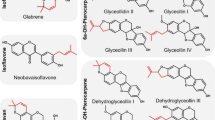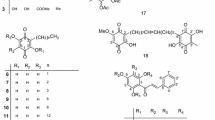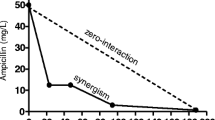Abstract
Methicillin-resistant Staphylococcus aureus (MRSA) is a bacterium responsible for several infections in humans. The infections caused by this bacterial strain are difficult to treat due to the resistance of MRSA to clinically used antibiotics. Several medicinal plants extracts and their phytoconstituents have been reported to possess modulation and efflux pump inhibitory (EPI) activity against MRSA strains. Alpinia calcarata rhizomes have been reported to be used in Ayurveda for several ailments including fungal infections. Based on this information and in continuation with our efforts to discover EPIs from Indian medicinal plants, we describe EPI activity of flavonoids isolated from A. calcarata. Galangin and kaempferol showed ≥ 32-fold modulation in minimum inhibitory concentration (MIC) of ethidium bromide (EtBr) as well as norfloxacin in NorA-overexpressed S. aureus (SA-1199B) strain. Pinocembrin showed 32-fold modulation of EtBr MIC in SA-1199 strain, but not in SA-1199B and K1758 strains. A significant difference was not observed in the modulation of norfloxacin MIC by galangin in SA-1199 and SA-1199B strains, which may be due to non-specific nature of galangin as modulator or EPI. However, kaempferol modulated the MIC of EtBr as well as norfloxacin 64-fold and 32-fold, respectively. Also, the best modulatory effect of kaempferol was observed only in SA-1199B strain compared to two other strains. The EPI activity of kaempferol and galangin were found to be competitive with respect to verapamil. In dose-response assay, kaempferol at 31.25 μg/mL concentration was found to be better EPI by inhibiting NorA pump in SA-1199B strain and also demonstrated further confocal microscopy.
Similar content being viewed by others
Abbreviations
- CC:
-
column chromatography
- DMSO:
-
dimethyl sulfoxide
- EPI:
-
efflux pump inhibitory
- EtBr:
-
ethidium bromide
- FIC:
-
fractional inhibitory concentration
- FICI:
-
fractional inhibitory concentration index
- MHB:
-
Mueller-Hinton growth medium
- MIC:
-
minimum inhibitory concentration
- MF:
-
modulation factor
- MRSA:
-
methicillin-resistant Staphylococcus aureus
- MTT:
-
3-(4,5-dimethylthiazol-2-yl)-2,5-diphenyltetrazolium bromide
- TLC:
-
thin layer chromatography
References
Arambewela L.S., Basnayake C.S., Serasinghe P., Tissera MS., Dias S. & Weerasekara D.R. 1995. Traditional Treatment in Sri Lanka for Chronic Arthritis. NARESA Printing Unit, Colombo, Sri Lanka.
Arambewela L.S.R. & Arawwawala L.D.A.M. 2005. Antioxidant activities of ethanolic and hot aqueous extracts of Alpinia calcarata rhizomes. Aust. J. Med. Herbalism 17: 91–94
Arambewela L.S.R., Arawwawala L.D.A.M. & Ratnasooriya W.D. 2004. Antinociceptive activities of aqueous and ethanolic extracts of Alpinia calcarata rhizomes in rats. J. Ethnopharmacol. 95: 311–316
Arambewela L.S.R., Arawwawala L.D.A.M. & Ratnasooriya W.D. 2005. Gastroprotective activity of hot ethanolic extract of Alpinia calcarata rhizomes in rats. Ceylon J. Med. Sci. 48: 1–11
Basak S., Sarma G.C. & Rangan L. 2010. Ethnomedical uses of Zingiberaceous plants of Northeast India. J. Ethnopharmacol. 132: 286–296
CLSI 2006. Methods for Dilution Antimicrobial 448 Susceptibility Tests for Bacteria that Grow Aerobically. 7th Ed., Approved Standard, Clinical and Laboratory Standards Institute (CLSI) 449 document M7-A7, Vol. 26. CLSI, Wayne, PA.
Edelsberg J., Weycker D., Barron R., Li X., Wu H., Oster G., Badre S., Langeberg W.J. & Weber D.J. 2014. Prevalence of antibiotic resistance in U. hospitals. Diagn. Microbiol. Infect. Dis. 78: 255–262
Fontaine F., Héquet A., Voisin-Chiret A.S., Bouillon A., Lesnard A., Cresteil T. & Rault S. 2015. Boronic species as promising inhibitors of the Staphylococcus aureus NorA efflux pump: study of 6-substituted pyridine-3-boronic acid derivatives. Eur. J. Med. Chem. 95: 185–198
Garzoni C. & Kelley W.L. 2009. Staphylococcus aureus: new evidence for intracellular persistence. Trends Microbiol. 17: 59–65
George M. & Pandalai K.M. 1949. Investigations on plant antibiotics. Indian J. Med. Res. 37: 169–181
Gomez-Flores R., Gupta S., Tamez-Guerra R. & Mehta R.T. 1995. Determination of MICs for Mycobacterium avium-M. intracellulare complex in liquid medium by a colorimetric method. J. Clin. Microbiol. 33: 1842–1846
Handzlik J., Matys A. & Kiec-Kononowicz K. 2013. Recent advances in multi-drug resistance (MDR) efflux pump inhibitors of Gram-positive bacteria S. aureus. Antibiotics 2: 28–45
Hema P.S. & Nair M.S. 2009. Flavonoids and other constituents from the rhizomes of Alpinia calcarata. Biochem. Syst. Ecol. 37: 52–54
Ippolito G., Leone S., Lauria F.N., Nicastri E. & Wenzel R.P. 2010. Methicillin-resistant Staphylococcus aureus: the superbug. Int. J. Infect. Dis. 14: S7–S11.
Jayaweera D.M. 1982. Medicinal Plants Used in Ceylon. National Science Council of Sri Lanka, Colombo, 213 pp.
Ji J., Du X., Chen Y., Fu Y., Wang H. & Yu Y. 2013. In vitro activity of sulbactam in combination with imipenem, meropenem, panipenem or cefoperazone against clinical isolates of Acinetobacter baumannii. Int. J. Antimicrob. Agents. 41: 400–401
Kaatz G.W. & Seo S.M. 1997. Mechanisms of fluoroquinolone resistance in genetically related strains of Staphylococcus aureus. Antimicrob. Agents Chemother. 41: 2733–2737
Kaatz G.W., Seo S.M. & Ruble C.A. 1993. Efflux-mediated fluoroquinolone resistance in Staphylococcus aureus. Antimicrob. Agents Chemother. 37: 1086–1094
Kaleysa R.R. 1975. Screening of indigenous plants for anthelmintic action against human Ascaris lumbricoides. Indian J. Physiol. Pharmacol. 19: 47–49
Kong L.Y., Qin M.J. & Niwa M. 2002. New cytotoxic bis-labdanic diterpenoids from Alpinia calcarata. Planta Med. 68: 813–817
Kong L.Y., Qin M.J. & Niwa M. 2004. Two new bis-labdanic diterpenoids from Alpinia calcarata. Acta Bot. Sinica 46: 159–164
Kosmidis C., Schindler B.D., Jacinto P.L., Patel D., Bains K., Seo S.M. & Kaatz G.W. 2012. Expression of multidrug resistance efflux pump genes in clinical and environmental isolates of Staphylococcus aureus. Int. J. Antimicrob. Agents 40: 204–209
Lechner D., Gibbons S., & Bucar F. 2008. Plant phenolic compounds as ethidium bromide efflux inhibitors in Mycobacterium smegmatis. J. Antimicrob. Chemother. 62: 345–348
Pages J.M. & Amaral L. 2009. Mechanisms of drug efflux and strategies to combat them: challenging the efflux pump of Gram-negative bacteria. Biochim. Biophys. Acta 1794: 826–833
Poole K. & Lomovskaya O. 2006. Can efflux inhibitors really counter resistance? Drug Discov. Today — Therapeutic Strategies 3: 145–152
Pushpangadan P. & Atal C.K. 1984. Ethno-medico-botanical investigations in Kerala I. Some primitive tribals of Western Ghats and their herbal medicine. J. Ethnopharmacol. 11: 59–77
Raj G., Pradeep D.P., Yusufali C., Da M. & Baby S. 2013. Chemical profiles of volatiles in four Alpinia species from Kerala, South India. J. Essential Oil Res. 25: 97–102
Randhawa H.K., Gautam A., Sharma M., Bhatia R., Varshney G.C., Raghava G.P.S. & Nandanwar H. 2016. Cellpenetrating peptide and antibiotic combination therapy: a potential alternative to combat drug resistance in methicillinresistant Staphylococcus aureus. Appl. Microbiol. Biotechnol. 2: 1–11
Ratnasooriya W.D. & Jayakody J.R. 2006. Effects of aqueous extract of Alpinia calcarata rhizomes on reproductive competence of male rats. Acta Biol. Hung. 57: 23–35
Roy S.K., Kumari N., Pahwa S., Agrahari U.C., Bhutani K.K., Jachak S.M. & Nandanwar H. 2013. NorA efflux pump inhibitory activity of coumarins from Mesua ferrea. Fitoterapia 90: 140–150
Roy S.K., Pahwa S., Nandanwar H. & Jachak S.M. 2012. Phenlypropanoids of Alipina galanga as efflux pump inhibitors in Mycobacterium smegmatis mc2 155. Fitoterapia 83: 1248–1255
Sangwan P.L., Koul J.L., Koul S., Reddy M.V., Thota N., Khan I.A., Kumar A., Kalia N.P. & Qazi G.N. 2008. Piperine analogs as potent Staphylococcus aureus NorA efflux pump inhibitors. Bioorg. Med. Chem. 16: 9847–9857
Schmitz F.J., Fluit A.C., Luckefahr M., Engler B., Hofmann B., Verhoef J. & Jones M.E. 1998. The effect of reserpine, an inhibitor of multidrug efflux pumps, on the in-vitro activities of ciprofloxacin, sparfloxacin and moxifloxacin against clinical isolates of Staphylococcus aureus. J. Antimicrob. Chemother. 42: 807–810
Shin D., Kinoshita K., Koyama K. & Takahashi K. 2002. Antiemetic principles of Alpinia officinarum. J. Nat. Prod. 65: 1315–1318
Smith E.C., Kaatz G.W., Seo S.M., Wareham N., Williamson E.M. & Gibbons S. 2007. The phenolic diterpene totarol inhibits multidrug efflux pump activity in Staphylococcus aureus. Antimicrob, Agents Chemother. 51: 4480–4483
Stavri M., Piddock L.J.V. & Gibbons S. 2007. Bacterial efflux pump inhibitors from natural sources. J. Antimicrob. Chemother. 59: 1247–1260
Subramoniam A., Madhavachandran V. & Gangaprasad A. 2013. Medicinal plants in the treatment of arthritis. Annal. Phytomed. 2: 3–36
Truong-Bolduc Q.C., Strahilevitz J. & Hooper D.C. 2006. NorC, a new efflux pump regulated by MgrA of Staphylococcus aureus. Antimicrob. Agents Chemother. 50: 1104–1107
Urbatsch L.E., Mabry T.J., Miyakado M., Ohno N. & Yoshika H. 1976. Flavonol methyl ethers from Ericameria diffusa. Phytochemistry 15: 440–441
Acknowledgements
HKR thankful to CSIR’s network project (BSC-121) for the project fellowship, HSN is thankful to CSIR, India, for funding through its network project (BSC-121).
Author information
Authors and Affiliations
Corresponding authors
Rights and permissions
About this article
Cite this article
Randhawa, H.K., Hundal, K.K., Ahirrao, P.N. et al. Efflux pump inhibitory activity of flavonoids isolated from Alpinia calcarata against methicillin-resistant Staphylococcus aureus. Biologia 71, 484–493 (2016). https://doi.org/10.1515/biolog-2016-0073
Received:
Accepted:
Published:
Issue Date:
DOI: https://doi.org/10.1515/biolog-2016-0073




